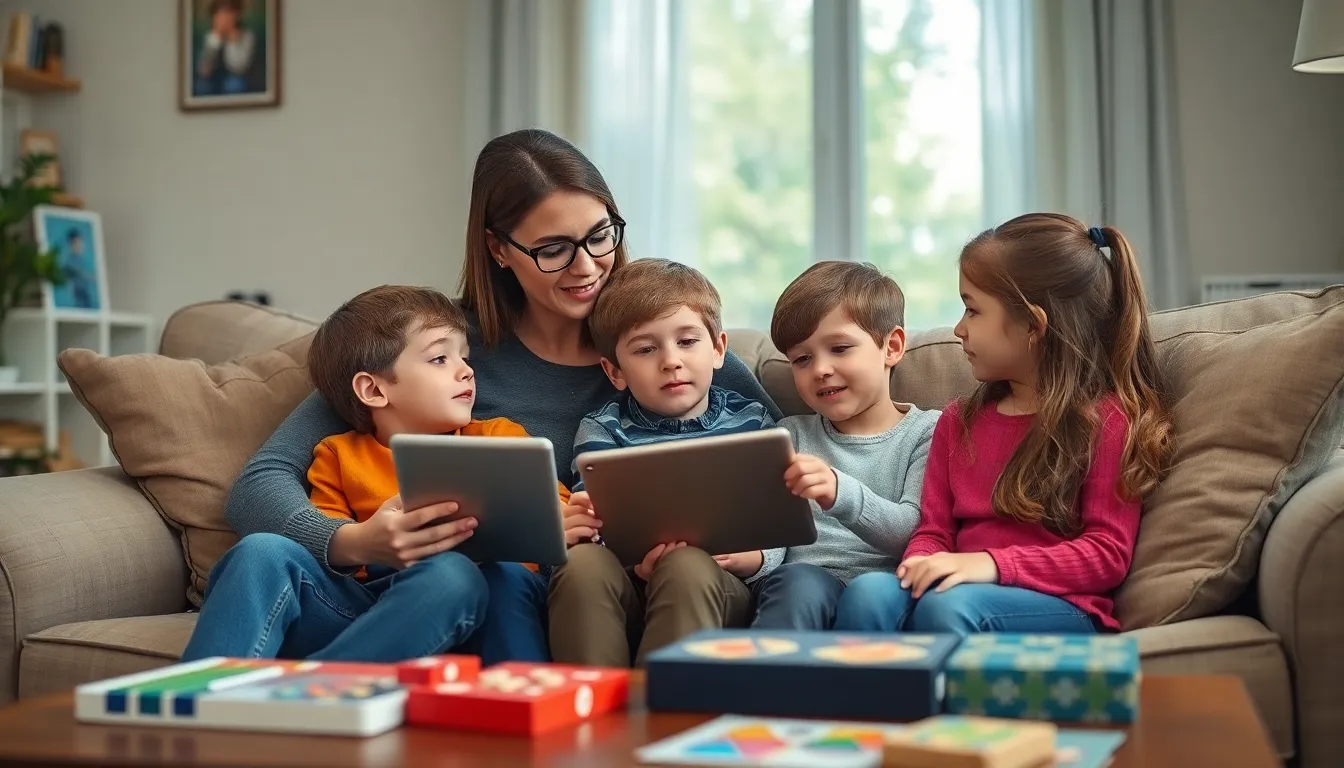Artificial Intelligence is reshaping industries and challenging traditional norms, sparking a wave of innovative experiments. From healthcare to finance, AI experiments are pushing boundaries and unveiling new possibilities. These trials not only improve efficiency but also enhance decision-making processes, making them crucial in today’s fast-paced world.
As researchers and companies dive deeper into AI, they’re discovering groundbreaking applications that were once considered science fiction. These experiments are not just about developing smarter algorithms; they’re about understanding how AI can coexist with human intelligence. With each experiment, insights emerge that could redefine the future of technology and its role in society.
Table of Contents
ToggleOverview of AI Experiments
AI experiments involve systematic investigations into the capabilities and applications of artificial intelligence. Researchers and developers conduct these experiments to explore innovative solutions that improve existing processes and create new opportunities.
Types of AI Experiments
- Machine Learning Models: Machine learning experiments focus on training algorithms with large datasets. Techniques such as supervised and unsupervised learning enhance model accuracy and efficiency.
- Natural Language Processing: Natural language processing experiments analyze communication between humans and machines. Improvements in language understanding lead to advancements in chatbots, translation services, and sentiment analysis.
- Computer Vision: Computer vision experiments examine how machines interpret visual data. These projects contribute to advancements in facial recognition, autonomous vehicles, and medical imaging analysis.
- Robotics: Robotics experiments integrate AI with physical machines. Developments in robotics enhance automation in manufacturing, healthcare, and service industries.
Notable AI Experiments
| Experiment Name | Description | Year |
|---|---|---|
| AlphaGo | A program that defeated a world champion in Go. | 2016 |
| GPT-3 | A language model capable of generating human-like text. | 2020 |
| IBM Watson | An AI system that won Jeopardy! and supports healthcare. | 2011 |
| OpenAI Codex | An AI model for code generation and assistance. | 2021 |
Key Outcomes of AI Experiments
- Increased Efficiency: AI experiments lead to significant reductions in processing time across various sectors. For example, automating data entry minimizes human error and accelerates workflows.
- Enhanced Decision-Making: AI provides predictive insights based on data patterns, assisting organizations in strategic planning and risk management.
- Innovation in Services: Different sectors witness the introduction of AI-driven products and services. Businesses enhance user experiences through AI technologies that personalize offerings based on customer behavior.
AI experiments play a crucial role in transforming ideas into successful applications. As the AI field evolves, ongoing experimentation fosters deeper understanding and paves the way for future breakthroughs.
Types of AI Experiments

AI experiments encompass various methodologies aimed at enhancing artificial intelligence capabilities. Each type serves distinct purposes and objectives within the AI landscape.
Supervised Learning Experiments
Supervised learning experiments involve training algorithms on labeled datasets. These datasets contain both input data and output labels, allowing the model to learn correlations and patterns. Common applications include:
- Classification tasks: Identifying categories, such as email filtering into spam or non-spam.
- Regression tasks: Predicting continuous values, like housing prices based on various features.
Notable examples include the development of image classification models and sentiment analysis tools that distinguish positive and negative sentiments in text.
Unsupervised Learning Experiments
Unsupervised learning experiments focus on discovering hidden patterns within unlabeled data. These models gain insights without predefined outcomes, making them useful for exploratory analysis. Key applications include:
- Clustering: Grouping similar data points, such as customer segmentation in marketing strategies.
- Dimensionality reduction: Simplifying datasets while retaining essential information, often used in visualization and data compression.
Famous instances involve the use of clustering algorithms like k-means and hierarchical clustering in analyzing large datasets.
Reinforcement Learning Experiments
Reinforcement learning experiments emphasize learning through interactions with an environment. Here, agents receive feedback in the form of rewards or penalties based on their actions. This approach thrives in dynamic settings. Key elements include:
- Value-based methods: Agents estimate future rewards to make decisions, utilized in game playing by AI models, such as AlphaGo.
- Policy-based methods: Directly optimizing decision-making strategies, applicable in robotics and automated systems to enhance efficiency.
Prominent examples include training robots to perform complex tasks through trial and error, showcasing significant advancements in adaptive AI capabilities.
Notable AI Experiments
Notable AI experiments exemplify groundbreaking advancements and significant impact on various fields. These experiments showcase AI’s potential to redefine traditional systems and create innovative solutions.
AlphaGo: A Turning Point
AlphaGo represents a crucial milestone in AI development. Developed by DeepMind, AlphaGo made headlines by defeating the world champion Go player in 2016. This event highlighted AI’s capability to excel in complex strategic games. AlphaGo employs deep neural networks and reinforcement learning to evaluate board positions and make informed decisions. The sophistication of AlphaGo demonstrated that AI could master tasks previously thought to be the sole domain of human intelligence.
OpenAI’s GPT Models
OpenAI’s Generative Pre-trained Transformer (GPT) models, including GPT-3, showcase the advancement of natural language processing (NLP). These models utilize a transformer architecture, enabling them to generate coherent and contextually relevant text based on user prompts. GPT-3 consists of 175 billion parameters, allowing it to understand and produce human-like responses across various topics. Applications of the GPT models include chatbots, content creation, and code generation, illustrating the versatility of AI in language tasks.
Ethical Considerations in AI Experiments
Ethical considerations are vital in AI experiments due to the potential societal impacts. Researchers must address issues of bias, privacy, accountability, and transparency to ensure responsible AI development.
- Bias in AI Models: AI systems can perpetuate existing biases present in training data, leading to unfair outcomes. Ensuring diverse and representative datasets during experiments minimizes bias-related risks.
- Privacy Concerns: AI experiments often involve processing large amounts of personal data. Protecting user privacy through data anonymization and secure data handling practices is essential for ethical compliance.
- Accountability: As AI systems make autonomous decisions, establishing clear accountability structures becomes crucial. Stakeholders must define who is responsible for the actions and outcomes of AI applications.
- Transparency: Transparency in algorithms promotes trust and understanding of AI decisions. Researchers should strive to make AI models interpretable and share insights into decision-making processes.
- Informed Consent: Participants in AI experiments must provide informed consent, understanding how their data will be used. Clear communication about the purpose and scope of AI-related research fosters ethical practices.
- Impact on Employment: Automation driven by AI experiments raises concerns about job displacement. Addressing these challenges through workforce reskilling and adaptation strategies is necessary for ethical progress.
AI experiments present significant ethical challenges, and addressing these considerations is critical for fostering innovation while mitigating risks.
Future Directions for AI Experiments
Emerging trends in AI experiments suggest a shift towards enhanced autonomy and collaboration. Researchers and developers increasingly focus on integrating AI systems that work alongside humans rather than replacing them. This human-AI partnership enhances productivity while maintaining accountability.
AI experiments continue to advance machine learning techniques. Novel architectures, such as generative adversarial networks (GANs), enable the creation of realistic data and original content. These findings boost applications in art, music, and design, opening new avenues for creative expression.
Key Areas of Exploration
- Federated Learning: This approach focuses on training algorithms across decentralized devices while preserving data privacy. Developers leverage federated learning to offer personalized services without compromising sensitive information.
- Explainable AI: As AI systems grow more complex, the need for transparency increases. Explainable AI aims to develop algorithms that provide understandable justifications for their decisions, fostering trust and easing integration into critical sectors like healthcare and finance.
- AI for Social Good: Experiments increasingly target societal challenges, including climate change, healthcare disparities, and disaster response. Innovative AI solutions contribute to data analysis and resource management, driving forward impactful initiatives.
- Edge AI: Deploying AI applications on devices at the data source minimizes latency. Edge AI enhances real-time analytics in fields such as autonomous vehicles and industrial automation, addressing the need for immediate decision-making.
- Neurosymbolic AI: Combining neural networks with symbolic reasoning enables machines to understand and reason about the world. This direction enhances the ability to solve complex problems, bridging the gap between perception and cognition.
Collaborative Frameworks
Global partnerships among academia, industry, and government shape future AI experiments. These collaborative efforts foster knowledge sharing that accelerates innovation while addressing ethical implications. Multi-stakeholder discussions identify regulatory frameworks that ensure responsible AI development, emphasizing the importance of fairness and accountability.
Integration with Quantum Computing
Quantum computing offers potential breakthroughs in processing speeds for AI algorithms. Future experiments may explore how quantum processors enhance data analysis and model training, expediting discoveries across various fields, including pharmaceuticals and materials science.
AI experiments are set to evolve significantly, focusing on collaboration, privacy, transparency, and tackling societal issues, while also integrating emerging technologies to broaden their impact and applications.
AI experiments are reshaping the landscape of technology and society. They’re not just enhancing efficiency but also driving innovation across various fields. As these experiments evolve, they reveal new possibilities and applications that challenge conventional boundaries.
The commitment to ethical considerations ensures that advancements in AI are made responsibly. This balance between innovation and responsibility will be critical as AI continues to integrate into everyday life.
Looking ahead, the future of AI experiments promises exciting developments that could redefine human-computer interaction and address complex challenges. The journey of exploration and discovery in AI is just beginning and holds immense potential for transformative change.




